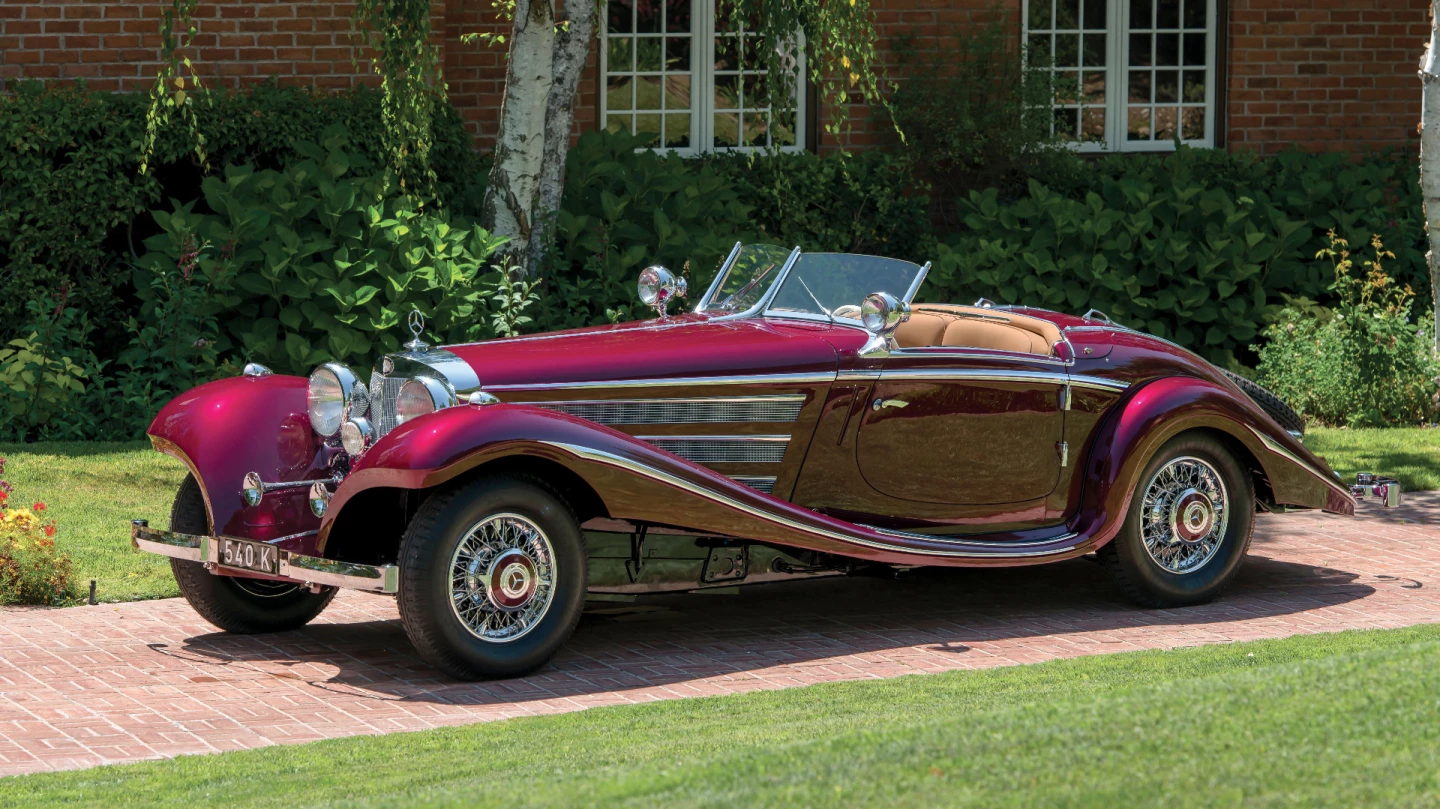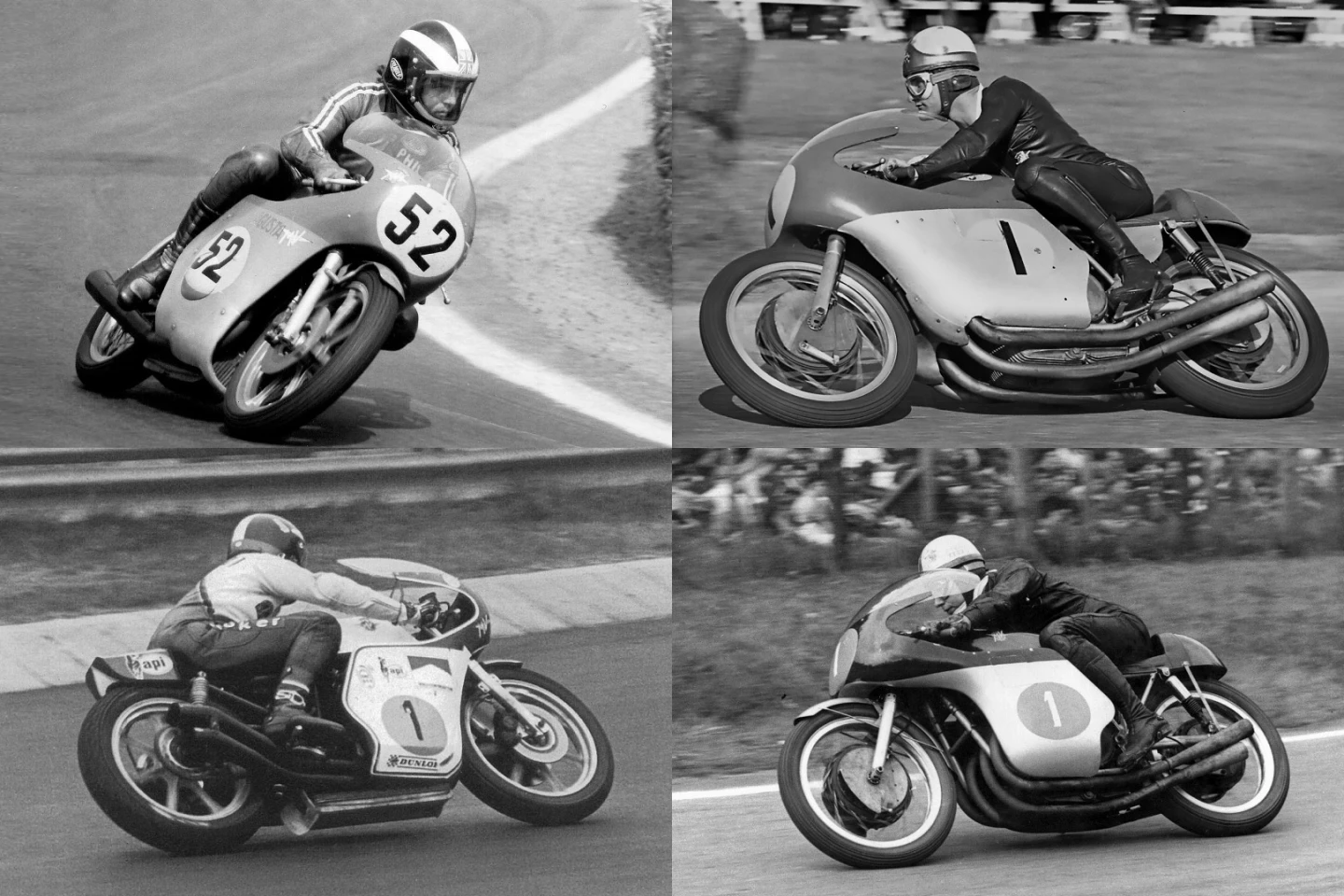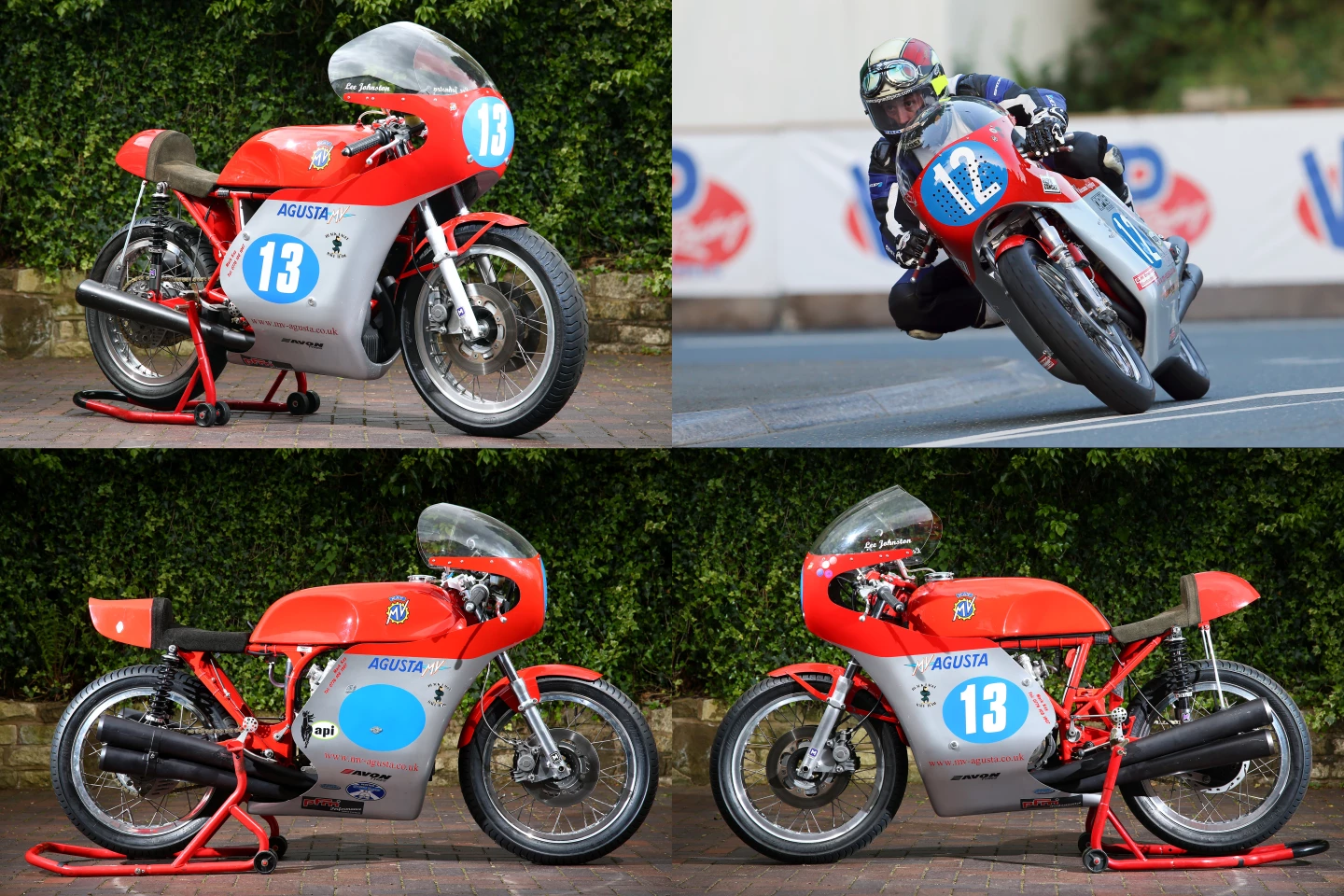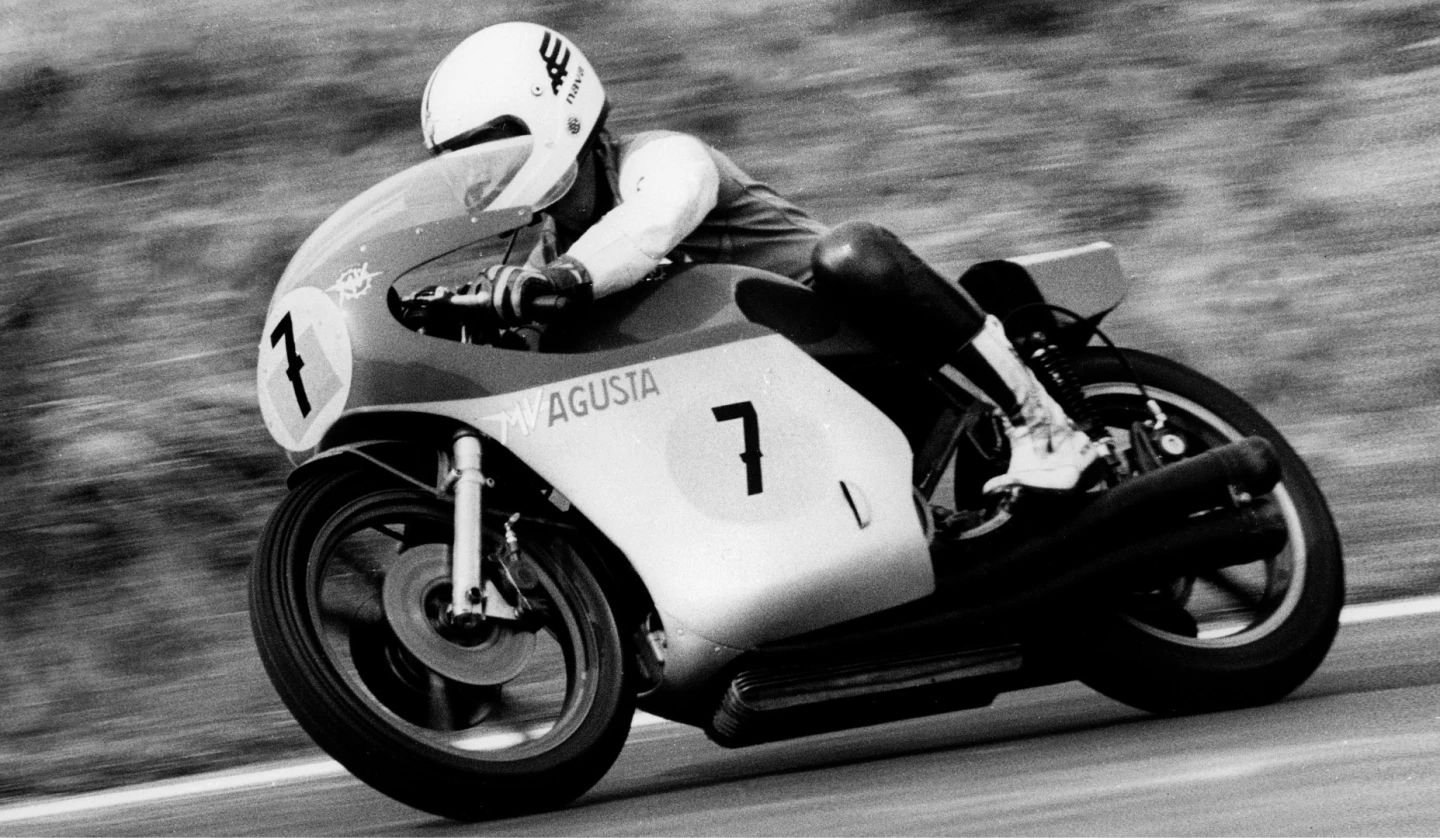One of the world's wealthiest and most enthusiastic motorcycle enthusiasts died last year, leaving an extraordinary motorcycle collection containing five spectacular Italian racing machines – two 1968/69 MV Agusta 350cc three-cylinder racers, a 1974 MV Agusta 500cc four-cylinder racer and a 1972 500cc three-cylinder racer plus a 1957 Gilera 500cc four-cylinder racer.
The primary determining factor in how much they will sell for is that the bikes are not originals, but perfect copies built in recent times by MV Meccanica Verghera (UK). Hence the estimated prices are but a fraction of what an otherwise identical (but original) machine would sell for. There are pros (getting your hands on some awesome machinery at a huge discount) and cons (resale value) and this article seeks to paint the full picture.
MV Meccanica Verghera (UK) is the leading supplier of parts for pre-1980 MV Agustas, and many of the surviving original race bikes around the world – not to mention owners of pre-1980 MV Agusta road bikes – rely on the UK company for spare parts.
Collectors love authenticity, a point that becomes clear with any analysis of auction results.
A first-edition book sells for much more than a second edition, but not nearly as much as an autographed manuscript. A guitar owned and played by Eric Clapton is worth many orders of magnitude more than an otherwise identical guitar. Similarly, the original MV Agusta ridden by Giacomo Agostini, Mike Hailwood, John Surtees or Phil Read, will be worth a lot more than a replica. The question is, how much more will it sell for if the bike is absolutely identical?
We examined this phenomena in the automotive space last year looking at the prospects for the auction of a Mercedes Benz 540K Spezial Roadster, which was, like the MV Agusta and Gilera racers featured in this article, as close to perfect as human beings can make.
This particular Mercedes-Benz (pictured below) was created by an acknowledged master of metal fabrication (Cass Nawrocki, he actually did write the book on metal fabrication), but the key parts of the car were born as part of a Mercedes-Benz 540K Cabriolet B and had been converted into a Spezial Roadster. So although no one could tell the difference, it wasn't a "real one."

Only 25 Mercedes–Benz 540K Spezial Roadsters were ever made, hence the world-record price for a 540K Spezial Roadster is an astonishing US$11.77 million (Gooding & Co, Pebble Beach, 2012), with an RM-Sotheby's sale of $9.9 million at Scottsdale in January 2016 and another of $9.7 million in Monaco in 2011 rounding out the top three.
So instead of fetching around $10 million, which it would have been worth with the right history, it sold for $1.87 million – that's 15 to 20 percent of the going price for an original in similar condition.
Racetrack competitiveness now a key variable in the equation

There's one key variable in this particular equation that has driven auction prices in classic cars and motorcycles for several decades now – racetrack competitiveness. Bikes that can make you competitive in classic racing tend to hold a special place in one's heart and this reflects on the prices fetched on the auction block.
Each of these bikes won it's world championship in it's respective year, not by a little, but so dominantly that even 50 years later that dominance still plays out in classic racing events.
As we're all aware, automotive technology has come a long way in 50 years and many of the bikes fielded in classic events are now producing 50 percent more rear wheel horsepower than the equivalent factory racers did in their time. Metallurgy and internally resculpted cylinder heads and cam profiles make up most of that difference, but more accurate machining, better fuels, lubricants and sealants all add up, and vastly improved suspension internals and tire construction complete the transformation.
The MV Agusta race bikes, though, are identical in every respect to the bikes raced by Agostini and Read, with the sole exception of an electronic ignition that is primarily there to ensure that the bikes won't exceed their rev limits and make an expensive bang.
What's more, despite the massive leap in performance of all other bikes on the classic racing grid and their complete authenticity to the period, they are still winning.
Scarcity is another prime determinant of auction prices, and the genuine race bikes from the Robert White Collection are rarer than even a Mercedes-Benz Spezial Roadster.
Robert White and his collection of awesome stuff

Robert White collected one of the most fascinating arrays of motorcycles outside a museum. Last year, Robert died at 62 from a rare form of cancer and, as was his wish, the proceeds from the sale of his boys' toys collection of watches, cameras, cars and motorcycles will be donated to Poole Hospital where he was treated.
As a successful entrepreneur in the British retail photographic industry, Robert amassed the wherewithal to collect an array of beautiful things. The lots to be offered at auction has yet to be finalized, but includes several of his beloved Leica cameras (such as this Leica MP-294 estimated at £15,000 to £20,000), some wonderful cars (a 1930 Bentley Le Mans 4.5-Litre Tourer estimated at £450,000 to £550,000 and a 1958 AC Ace Sports estimated at £180,000 to £220,000), a George Daniels watch (£70,000 to £100,000), a steam locomotive (no details yet) and a truly splendorous motorcycle collection.

Knowing his time was drawing near, Robert sold his clutch of Brough Superior motorcycles to friend and media personality Jay Leno for £3.5 million (US$4.6 million). Robert and Jay had bonded many years ago through their love of the marque and that money went straight to create a brand new cancer treatment center at Dorset County Hospital and new diagnostic facilities at Poole Hospital, both overseen by the latter's Dorset Cancer Centre.
Now the rest of the collection is up for grabs at a London Bonhams auction on 19 September, 2016, and the money will also go to the Poole Hospital.

The collection includes a 1929 Megola 640cc Tourer (ultra rare and expected to be the most expensive motorcycle in the collection – no auction link yet, but that's it bottom right with a five cylinder radial motor inside the front wheel – detail pics in the image gallery), a 1951 Vincent Series C Black Shadow, an Egli-Vincent (built for Robert in 2004by the renowned Vincent specialist, Patrick Godet), a 1931 Henderson 1,301cc KJ Four, an original "round case" Ducati 750SS, a 1940 Indian 78 ci Type 440 Four, a 1914 FN 700 Four, a 1970 MV Agusta 592cc Tourer and the bike that it would eventually become, the 1974 MV Agusta 750S. Not pictured above, but also very desirable is a 1953 MV Agusta 125cc Monoalbero production racer.
There will be more motorcycles announced closer to the auction date, but it's the works replica racers that are the focus of my deepest intrigue and this article. I grew up watching Ago and Phil Read make history on the MV Agustas and there really is nothing quite like the sound of one of these bikes in full flight.
MV Meccanica Verghera (U.K.)

The Midlands (U.K.) Kay family makes beautiful motorcycles. The family company was originally named Kay Engineering, but when MV Agusta closed it's doors in 1980, Kay Engineering began manufacturing spare parts for the road and race bikes and things got started from there. After winning the rights to use the name, the three-generation family company now trades as MV Meccanica Verghera (U.K.).
In addition to the spare parts, the company builds whole bikes from scratch, the old way, and no part can't be recreated. MV Meccanica Verghera (U.K.) is the two-wheeled equivalent of the famous Argentine Company Pursang, which I wrote about in this year's Techno-Classica report. Pursang is the company you go to if you want a period race car, such as a Type 35 Bugatti or Alfa 8C Monza, produced with authentic everything, right down to the finest detail, all brand new. In that report, I wrote: Let's say you've just spent a couple of million on a period race car of significant provenance and desperately want to race it, but it's too valuable to race with a clear conscience because it should be in a museum. Well you can take it to them and they'll replicate it – perfectly! Then you can get crazy in the replica while the real one stays warm and safe in your climate-controlled garage.
Exactly the same can be said for MV Meccanica Verghera (U.K.), which was founded by David Kay, who's best known for designing the world's only Ferrari motorcycle in the early 1990s, then spending 3,000 hours creating, with Ferrari's blessing, a double overhead camshaft 900cc four worthy of the Prancing Horse logo, with magnesium casings and Reynolds 531 frame. The bike was shown publicly for the first time in 1995, creating quite a media storm and, not surprisingly, when it went to auction in 2012, it became one of the top 100 most valuable motorcycles in the world, selling for £85,500 (US$139,066). That's it above.
Dave's son Mark joined the team and between them they have forged a reputation for supreme craftsmanship that is now global. Now the next generation, Mark's son Mitch, has joined the company and the artisanship is set to continue for decades to come.
Mark met Robert White some 35 years ago. "He was a good bloke," says Mark, "and I'm going to miss him in many ways because he became my best customer too."
"Whenever an opportunity came along to build a new bike, Robert would support the project in some way, and that's how he ended up with five of our bikes."
"He was more than an enthusiast really. When we were getting the 500 triple ready to race at the Isle of Man, he sponsored us and helped out in so many different ways to get us on the grid."
1957 Gilera 500cc Grand Prix Racer

The 1957 Gilera 500cc Grand Prix Race Replica was the first of the Kay Engineering race bike recreations. Gilera dominated the first decade of world championship motorcycle racing, winning the premier class in 1950, 1952, 1953, 1954, 1955, and finished racing at the end of 1957 after winning the championship one last time. As the final version of a bike with a decade of world championship-winning development behind it, the 1957 model is one of the most desirable racing bikes in history.
As there were so few built, the surviving factory Gilera fours from the period are now in museums or closely held in private collections, and thus extremely unlikely ever to be offered for public sale. With the explosion in interest and participation in classic racing of the last few decades, it was inevitable that it would eventually lead to the construction of replicas of these precious thoroughbreds, and so it came to pass.
After obtaining a loan machine, dismantling and copying every last nut and bolt, the Kays began producing replicas of the final 1957 championship-winning Gilera four – perfect copies of the bike which won all but one Grands Prix that year (1957), with the Gilera fours finishing first, second and fourth in the championship ridden by Libero Liberati, Bob McIntyre and Geoff Duke, respectively.
In all, MV Meccanica Vergerha has now made six 1957 Gilera four replicas, and two have previously come up for auction, one that sold for £84,000 (US$138,667) at Bonhams' Stafford in April, 2011, and another that fetched £76,300 (US$112,184) in April, 2009 in the aftermath of the global economic calamity.

They're made to order, so you can still buy one new from MV Meccanica Vergerha (U.K.) with the price around GBP£90,000 (US$115,000). The pics in the image gallery, apart from that of Rob White racing the bike to be auctioned (directly above), are all of the previously auctioned bikes, but they are all exactly the same as those bikes that were campaigned by Liberati, McIntyre and Duke at Hockenheim, Spa-Francorchaps, Dunrod, Monza and the Isle of Man in 1957.
Accordingly, we think the Bonhams estimate is a bit light at between £50,000 and £60,000 (US$65,000 to $78,000). A real one is unlikely to ever become available, and getting one outside the six already built by the Kays will cost $115,000 and involve a lengthy waiting period, even after the $30,000 Brexit currency exchange discount. Such is the price of a bike certain to get you on the front row of the grid for appropriate classic racing, but it's small money for a competitive bike, and much cheaper to race than a modern bike.
MV Agusta's Glorious Racing Motorcycles

MV Agusta is the most magical name in motorcycle racing. Between 1949 when World Championship Motorcycle Racing began, and the company's last race win in the premier class in 1976, MV Agusta's fabulous "fire engines" won 75 World Championships (riders & manufacturers)and 270 Grands Prix. In the premier 500cc class alone, its bikes won 139 Grands Prix and 16 World Riders Championships, with another 76 Grand Prix wins and nine World Riders Championships in the 350cc class.
MV Agusta won the World 500cc championship (now MotoGP) every year from 1958 to 1974, with the machines of John Surtees (bottom right in the above image on a 350/4), Gary Hocking, Mike Hailwood (top right), Giacomo Agostini (bottom left) and Phil Read (top left) virtually unbeatable until two-stroke technology finally banished all four-stroke machinery from the winner's circle.

Once Honda pulled out of Grand Prix racing at the end of 1967, MV Agusta continued the fight as the last competitive four-stroke for another decade before two-stroke domination became complete across all classes of motorcycle racing. Defiant to the end, MV Agusta's last race was the German Grand Prix at the Nurburgring on August 29, 1976 with Giacomo Agostini taking one last Senior (500cc) victory before that glorious exhaust sound was silenced.
Despite all those years of winning, the MV Agusta race team was small and an extremely limited number of these machines were built, and they have long since disappeared into collections and will not be sold for many years to come. They are exactly the type of bike that don't come to auction, being passed between friends, or promised to museums or famous collections long before their owners are finished with them.

Only one of these extremely rare factory bikes has ever come to auction. In 2007, John Surtees 1957 MV Agusta 500 (pictured above) went to auction with an estimate of £160,000 to £180,000, and despite the best efforts of the world's foremost elite motorcycle auction house (Bonhams), failed to make reserve.
If it had sold towards the upper end of Bonhams' estimate, it would have become the most valuable motorcycle ever sold. The record at that time was held by a 1907 Harley-Davidson "Strap Tank" Singlewhich was sold by Gooding & Co for US$352,000in 2006 as part of the Otis Chandler Collection, so although the above machine would have been a fabulous buy in hindsight, it was a lot of money for a motorcycle just a decade ago. As an aside, the 1957 MV Agusta only won one Grand Prix that year, being beaten in every other race by the same model Gilera 500/4 that features in this article. It was the least credible and hence desirable of any MV multi.
The two 1968/69 model 350cc three-cylinder MV Agustas

Robert wanted an MV Agusta race bike, so when the Kays managed to get hold of Agostini's three-cylinder 1968/69 model 350cc factory bike on loan, Robert backed the project to recreate it.
In period, this was far and away the fastest 350cc class bike in the world. In 1968 it won every 350cc Grand Prix (seven from seven), and in 1969 it again won the first 10 Grands Prix straight, then with the marque having clocked up enough points to take both 350cc and 500cc titles, MV Agusta did not attend the final two races of the season. That is, this bike won 17 straight Grands Prix before being replaced. That's the pit wall circa 1969 below with company founder Count Domenico Agusta watching over his charges. MV Agusta motorcycles was created as a subsidiary of Costruzioni Aeronautiche Agusta Spa – a much larger aviation company founded by the Count's father and now part of helicopter design and manufacturing company AgustaWestland.

The deal between Rob White and the Kays involved making one 350cc four-cylinder bike for the Kay's racing effort, now known as the Black Eagle Racing Team, and one for Rob, with no other copies of the bike to be produced while Robert was alive. When the Kay bike finished third in the Classic 350cc TT at the Isle of Man, Rob White bought that bike too, and a third machine was constructed so the Kays could keep racing. Both of Rob's 350/4s are for sale at this auction, with estimates of between £50,000 and £60,000 (US$65,000 to $78,000).
We asked Mark Kay if he would now build any more replicas of the 1968/1969 350/3 MV Agusta and his response was, "If someone came with the money and wanted one, of course we would ... it's what we do."
The price? "Around £120,000 to £125,000, depending on whether they wanted to parade it or race it", said Mark, indicating that the additional work required to build a machine to be mercilessly thrashed required considerable additional effort.
Once again, we think the estimate is very conservative, particularly considering that just a few months back with the USD-GBP exchange rates vastly different, you'd have paid $200,000 for an identical replica, and the Brexit devaluation discount means a new one is now worth $160,000. Buying one of these bikes within it's estimate would be an absolute steal, IMHO.
The 1972 500cc three-cylinder MV Agusta

The 1972 500cc three-cylinder MV Agusta won the first 11 Grands Prix of the season (10 to Agostini, one to Alberto Pagani when Ago's bike experienced problems), before doing as had become customary for the factory and missing the final Grand Prix once the titles were sewn up. Hence, like the 350 triple above, it had a perfect race record – 11 starts, 11 wins. Such was the dominance of MV Agusta that it regularly went through entire seasons undefeated. No Formula One car has ever achieved this feat.
The 1972 500cc three-cylinder race bike was the first MV Agusta that the Kay's replicated and the Black Eagle Racing Team's 2015 results in the Isle of Man Classic 500cc TT speak for themselves, with Dean Harrison taking first place at an average speed of 108.855 mph (175.185 km/h) lap and Lee Johnson taking third with a 107.972 mph (173.764 km/h) average. These are not just pretty replicas, they do the business exactly as they did 50 years ago.

Mark Kay (above right with his two 500 triples) estimates the price to create a new 500 three-cylinder replica like this one would be in the vicinity of £115,000 to £120,000, so the estimate of £70,000 to £90,000 would represent a discount on a new replica price.
The 1974 500cc four-cylinder MV Agusta

This model was the last of the MV four cylinder race bikes to win a World Championship, with Phil Read and Franco Bonera finishing first and second in the riders' championship, and the bike taking five (read, four wins, with one win to Bonera who is pictured on the 500/4 below) of the eight Grands Prix that year. Yamaha's four cylinder two-stroke 500 won three of the Grands Prix that year and the inevitability of complete two-stroke domination of the class was becoming clear. It was the Italian company's last world championship and it's seventeenth 500cc title in a row.

Hence the 1974 MV Agusta 500cc four is the last of the breed of Italian multi-cylinder racers that dominated Grand Prix Motorcycling for it's first quarter century. Many decades ago, I can remember standing next to one of the original bikes in the pits one day as an MV Agusta mechanic warmed it up before Agostini emerged, feeling supremely privileged to get so close to the stuff of legends. Now, I can scarcely believe that you can buy an exact replica.
MV Meccanica Vergerha has now re-created four 1974 MV Agusta 500cc fours and it is the most expensive motorcycle the company has produced, with Mark estimating the current cost for an identical bike would be in the vicinity of £210,000 (US$275,000). Almost apologetically, he added, "it's the amount of work in them that makes that difference."
"The 500 MV Agusta is a work of art on the inside too", he added. "It's a throughbred in every sense. By comparison, the Gilera which was the best in the world in it's time, even respecting that it is 20 years older, well ... it's a tractor by comparison."
Bonhams hasn't posted an estimate on the four-cylinder 500cc MV Agusta replica yet, but as Mark has elucidated, it costs a quarter million dollars just to make one, and while it may not be a "real one" it replicates exactly the same experience Giacomo Agostini would have had as he kept the two-stroke hordes at bay for one last win at Nurburgring on August 29, 1976 ... and that's priceless.
Magni MV Agusta F750 Replica

Now we don't know much about this bike as yet because the full catalog for the Robert White Collection has not been finalized, but we have been able to obtain images of what we believe is Robert White's Magni MV Agusta Formula 750 Replica. These bikes are manufactured by Magni in Italy, a company founded by legendary MV Agusta engineer Arturo Magni, whose career began under Piero Remor (designer of the Gilera 500/4 featured in this article) at Gilera and moved to MV Agusta in 1950. Magni's career then encompassed the entirety of MV Agusta's race activity until the factory race effort finished in 1976. These bikes are based on the 750 Sport and a Magni-designed chain drive conversion turns them into very powerful and much sought-after road and race bikes that routinely sell for more than $50,000. More when we have the details, though there are a few images of the bike in the image gallery.
and finally, the MV Agusta Six

There's only one thing IMHO, that sounds better than an MV Agusta four at full noise, and that's an MV Agusta six-cylinder. Perhaps expecting this answer, I asked Mark Kay if there was a bike he hadn't replicated that he wanted to re-create. He laughed!




















































